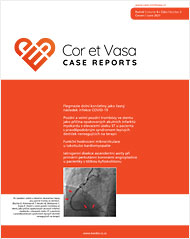 Cor et Vasa Case Reports
Cor et Vasa Case Reports
Svazek | Volume 4 • Číslo | Number 2
Červen | June 2021
 Cor et Vasa Case Reports
Cor et Vasa Case Reports
Svazek | Volume 4 • Číslo | Number 2
Červen | June 2021

K. Hořáková, M. Radvan, L. Koc, J. Sedmík, J. Hustý, P. Kala
Tromboembolické příhody jsou známou a obávanou komplikací COVID-19. Objevují se jak ve fázi akutní, tak v časném období po jejím překonání. Riziko stoupá se závažností průběhu infekce, ale ani lehký průběh závažné trombotické komplikace nevylučuje. Prezentujeme případ 58leté ženy, u které deset dní od ukončení izolace pro infekci COVID-19 došlo k prudkému rozvoji hluboké žilní trombózy zasahující až do dolní duté žíly, která se klinicky prezentovala jako flegmazie levé dolní končetiny. Po zavedení kaválního filtru do dolní duté žíly k prevenci embolizace trombotických hmot byla provedena endovaskulární léčba lokální trombolýzou, která časně vedla k rekanalizaci žilního řečiště a normalizaci klinického nálezu na končetině.

D. Buchta, et al.
Syndrom lepivých destiček (sticky platelet syndrome, SPS) je vrozená dědičná patologie zvyšující riziko trombotických stavů. Přestože je považován za relativně vzácné onemocnění, vyskytuje se až u 20 % pacientů, kteří trpí na trombotické stavy bez zjevné příčiny. K léčbě se používá kyselina acetylsalicylová, jejíž dávky do 100 mg/den u drtivé většiny pacientů normalizují agregaci, ve výjimečných případech dochází k normalizaci hodnot až při dávkách okolo 320 mg/den. V kazuistice předkládáme případ pacienta s pravděpodobným SPS (který však nemůže být s jistotou prokázán kvůli implantovaným stentům a z toho vyplývající nemožnosti vysadit antiagregační terapii), u nějž ani dávky kyseliny acetylsalicylové postupně zvyšované až na 400 mg/den v kombinaci s ticagrelorem a později prasugrelem nevedly k úplné normalizaci hodnot srážlivosti a který v průběhu pěti let léčby prodělal sedm dalších akutních infarktů myokardu typu 4b.

V. Brázdil, M. Hudec, L. Koc, T. Ondrúš, M. Poloczek, J. Kaňovský, R. Štípal, P. Jeřábek, O. Boček, P. Kala
Takotsubo kardiomyopatie (TTC) představuje akutní stav v kardiologii s narůstající incidencí, který často imituje akutní koronární syndrom. Společnými klinickými jmenovateli je typická bolest na hrudi, dušnost či synkopa. Nicméně pacienti s takotsubo kardiomyopatií mají ve většině případů normální koronární angiogram a typickou dysfunkci levé komory, která přesahuje zásobení jedné koronární tepny a zotavuje se během dnů či týdnů. I přes intenzivní výzkum probíhající v posledních letech přesná patogeneze TTC nebyla doposud zcela objasněna. Existuje celá řada možných mechanismů vzniku, jejichž společným jmenovatelem je aktivace sympatického nervového systému. V kazuistice popisujeme případ dvaasedmdesátileté ženy, vstupně vyšetřené pro typické známky akutního infarktu myokardu vzniklé ve vazbě na stresovou situaci. Koronarografické vyšetření prokázalo pouze nevýznamné změny na koronárních tepnách. Doplněná ventrikulografie odhalila obraz apikální dyskineze. Následná funkční měření neprokázala významné postižení koronární makrocirkulace, nicméně odhalila mikrovaskulární dysfunkci. Typický klinický průběh spolu s výsledky provedených vyšetření vedl k diagnostice TTC.

M. Mikulica, Z. Coufal, J. Šťastný
Popisujeme případ 74leté polymorbidní pacientky s těžkou kyfoskoliózou, která byla referována od praktického lékaře k provedení urgentní koronarografie pro akutní infarkt myokardu s elevacemi úseku ST (STEMI) na spodní a zadní stěně levé komory. Cestou pravé arteria radialis byla provedena pouze koronarografie pravé věnčité tepny (ACD), kde byl zjištěn uzávěr v její střední části, levou věnčitou tepnu bylo nutné zobrazit cestou levé arteria radialis pro extrémní vinutí aorty při deformitě páteře. Při následné sondáži ACD vodicím katétrem došlo k rozsáhlé disekci tepny s retrográdním šířením na ascendentní aortu. Případ jsme vyřešili implantací lékových stentů do proximálního a distálního segmentu ACD, další stent jsme implantovali do ostia ACD, čímž jsme pokryli reziduální disekci ACD a současně uzavřeli vstup do disekce ascendentní aorty. Depo kontrastní látky v ascendentní aortě zůstalo konstantní, bez progrese. Zvažovali jsme konzultaci kardiochirurgického pracoviště, nicméně...